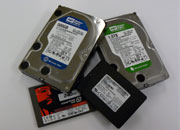Fall 2016 Volume 17, Issue 2
Getting to Know Your Hard Drives
by Kam Abado

Over the past few years, a new kind of hard drive has been "turning heads". Unlike a traditional hard disk drive (HDD), with its spinning magnetic platters and mechanical heads, a typical solid state drive (SSD) works more like a basic USB memory stick. SSD popularity is increasing over the traditional HDD because they are significantly faster, physically smaller and becoming just as reliable.
Why would you even want a traditional HDD? The HDD provides large storage capacity at a lower cost; however, many people are willing to sacrifice capacity for speed and will pay the premium for an SSD. Hybrid options, which have the functionality of SSDs and HDDs combined, balance speed and capacity for a better price.
You might expect a longer life span with SSDs versus HDDs due to the lack of moving parts. However, SSDs have flash memory that degrades over time and physical components can fail as well. The bottom line is that both HDDs and SSDs can, and eventually will fail. A dud drive may fail in its first year of life; some will last much longer. Once an SSD drive fails, we are unable to recover any of the data that was stored on it without significant expense. It is critical for you to have a backup plan. Please read the backup article in this newsletter for more information on backup.
Contact SSTS
Service Desk Request
519 661-2152
Ext. 82152
SSC Network Update
Managing Editor
Mary Van de Ven

